India
 From Rationalwiki
From Rationalwiki .svg.png)
India (Hindi: भारत, Bhārat) is a vast, very populated developing country (approximately 1.42 billion people as of 2022).[1] It is very proud of its spiritual heritage, having given the world Sikhism, Hinduism, Buddhism, and Jainism. It can also be a very fractious country, which makes sense if you skim its long, politically fragmented history.
It is a vast nation marked by important religious, ethnic, and linguistic divides, which have led to sporadic clashes between various groups since independence in 1947. While the country has had important episodes of conflict and endured a brief period of dictatorship under Indira Gandhi, known as "the Emergency," it remains the world's largest democracy, although the country underwent democratic backsliding since Narendra Modi became its Prime Minister in 2014.
Politics[edit]
India also serves as an example that shows that Eastern polytheistic religions are not as immune to fundamentalism and violence as many in the West like to believe. The constitution of India guarantees freedom of religion for all. However, religion is an important factor among parts of the country's population, as seen in the success of the Hindu fundamentalist (commonly known as Hindu nationalist) Bharatiya Janata Party (BJP, in English, Indian People's Party), the ruling political party in the country.[note 1] Additionally, religious law can govern personal matters such as divorce and inheritance, which has led to legal controversies. Indian blasphemy laws have also been used to punish criticism of religion, with conversion to or from any of them subject to legal hurdles.
Parties[edit]

There are two major political parties in India, the Indian National Congress![]() (INC) and the Bharatiya Janata Party (BJP). The Communist Party of India
(INC) and the Bharatiya Janata Party (BJP). The Communist Party of India![]() is another player in the southern state of Kerala, where, unlike its crazier Maoist cousins, it participates in parliamentary democracy and regularly (and surprisingly!) receives a large number of votes. However, many states are governed by so-called regional parties, which, more often than not, have their presence in that state only.[note 2] For example, the states of West Bengal and Odisha in east India or the states of Tamil Nadu and Andhra Pradesh in South India have large regional parties in power.
is another player in the southern state of Kerala, where, unlike its crazier Maoist cousins, it participates in parliamentary democracy and regularly (and surprisingly!) receives a large number of votes. However, many states are governed by so-called regional parties, which, more often than not, have their presence in that state only.[note 2] For example, the states of West Bengal and Odisha in east India or the states of Tamil Nadu and Andhra Pradesh in South India have large regional parties in power.
The INC is widely considered secular, and it has a center-left orientation in the political spectrum. However, the involvement of INC members in the anti-Sikh riots, coupled with statements of senior Congress leader Digvijay Singh where he described atheism as a negative attribute,[2] leaves the secular nature of the INC open to debate.[3][4]
The BJP has a center-right orientation and identifies itself as more conservative. Its parent, the right-wing RSS (Rashtriya Swayamsevak Sangh), has promoted extremist Hindutva and religious fundamentalist views by cherry-picking from ancient Indian texts and philosophers.
Other right-wing organizations like Shiv Sena,![]() [5] Bajrang Dal,
[5] Bajrang Dal,![]() [6] and some members of VHP[7] have been involved in hatred and violence towards Muslims and Christians. There have also been politicians who have called for violence against Hindus like Akbaruddin Owaisi. Recently one of the smaller political parties, the Aam Aadmi Party,
[6] and some members of VHP[7] have been involved in hatred and violence towards Muslims and Christians. There have also been politicians who have called for violence against Hindus like Akbaruddin Owaisi. Recently one of the smaller political parties, the Aam Aadmi Party,![]() won the Delhi Assembly Elections
won the Delhi Assembly Elections![]() against the two biggest political parties of the country, the BJP and INC.
against the two biggest political parties of the country, the BJP and INC.
India, along with the other seven South Asian countries, Pakistan, Bangladesh, Sri Lanka, Nepal, Maldives, Bhutan, and Afghanistan, is part of a regional coalition named SAARC. However, there are internal hostilities between India and Pakistan in SAARC, making SAARC an ineffective multinational alliance. India is also a member of BRICS, a bloc for emerging powers, where Brazil, Russia, India, China, and South Africa are the founding members.
India's relations with China are poor due to ongoing border disputes![]() dating back to a war in 1962. It also doesn't help that India gave asylum to the Dalai Lama after China annexed Tibet in 1959. Because of this, India's tiny Chinese community and Indians from the North East (more East Asian in appearance) face significant social discrimination. As the result of the last dispute in 2020, which turned deadly, India enacted a blanket ban on Chinese-owned software and apps. This naturally resulted in China having better relations with India's regional rivals, such as Pakistan and Sri Lanka. India has also banned the import of several Chinese goods and Chinese apps, including TikTok and AliExpress.
dating back to a war in 1962. It also doesn't help that India gave asylum to the Dalai Lama after China annexed Tibet in 1959. Because of this, India's tiny Chinese community and Indians from the North East (more East Asian in appearance) face significant social discrimination. As the result of the last dispute in 2020, which turned deadly, India enacted a blanket ban on Chinese-owned software and apps. This naturally resulted in China having better relations with India's regional rivals, such as Pakistan and Sri Lanka. India has also banned the import of several Chinese goods and Chinese apps, including TikTok and AliExpress.
In contrast, India has a far more friendly relationship with Russia, dating all the way back to the Soviet Union which supported India in its wars against the US-backed Pakistan. India was also pro-Soviet Union during the Sino-Soviet split. India is currently a major client for Russian resources and technology.
Economy[edit]
.jpg)
After independence in 1947, India tried to implement a socialist-type economy, led by their first prime minister Jawaharlal Nehru, who was a socialist. However, it was a socialist mixed economy rather than a Soviet-style command economy. India's economy was framed in this model until the collapse of the Soviet Union in 1991. After the USSR's dissolution, India adopted the Washington consensus and started to open its markets to the private sector. As of 2020, India has the 3rd largest PPP economy globally.[8] Some have estimated that India will become an economic superpower.[9] Despite this, poverty is a severe problem in India. Approximately 6.7% of Indians live below the poverty line.[10] The benefits of economic liberalization have not been equitably spread, with urban centers gaining a lot more than the villages. Bureaucratic corruption is also a severe problem in India, and it makes economic progress a mere fraction of its potential. Other social issues include poor nutrition and inadequate healthcare, and economist Amartya Sen noted that India's excessive mortality due to such problems often exceeded those of China during the Mao era, and India never had anything close to Mao's insane policies.[11]
India has its own currency, the Rupee[note 3] (sign: ₹; code: INR). It was the 20th most traded currency worldwide in 2013, right behind the Brazilian Real and the South African Rand.[12]
India ranks very low in terms of economic freedom.[citation needed]
According to the 2021 Global Slavery Index, an estimated 18 million people are enslaved in modern-day India, or 1.4% of the population. By this estimate, India has the fourth highest prevalence of slavery but the highest absolute number of enslaved people. This includes a variety of forms of slavery, including bonded labor, forced domestic service, forced begging, forced prostitution, forced marriage, and forced recruitment for armed services.[13]
According to the 2021 Global Hunger Index, India ranks 101 out of 116 countries, dropping from 94 the previous year. India is also behind its neighbors, with Pakistan at 92 and Nepal and Bangladesh at 76.[14] There was much propaganda from government outlets denying this score, but this was debunked.[15] The Modi government made no real progress in reducing hunger in India.
Military[edit]

Militarily, India is the strongest country in South Asia. The Indian military is the third-largest in the world in terms of military personnel, and the Indian Army is the second largest standing army. The Indian Navy is the fifth largest navy,[16] and the Air Force is the fourth largest air force globally.[17] Historically, the Indian military heavily relied upon Soviet arms and technical assistance, although it continuously developed indigenous technology. Since the collapse of the Soviet Union, India has built most modern military technologies domestically or in collaboration with foreign countries. The Indian Air Force maintains approximately 1300 combat and non-combat aircraft,[18] the Indian Army maintains nearly 5000 main battle tanks,[19] and the Indian Navy employs 155 vessels,[20] including one aircraft carrier. Six nuclear-powered submarines are under construction, and the Navy is undergoing rapid modernization and expansion. Aircraft of the Indian Air Force include the 4.5 generation fighter Sukhoi Su-30MKI, which is IAF's primary air superiority aircraft. India is a de facto nuclear power. At present, India possesses two intermediate-range ballistic missiles: Agni II with a range of 2,000–2,500 km and Agni III with a range of 3,500 km. India is developing an intercontinental ballistic missile named Surya.[21]
There are concerns about human rights violations associated with the Indian military. The Indian Peacekeeping Force in Sri Lanka is accused of human rights violations.[22] According to the Human Right Watch,
“”Attacks on civilians by militant groups[note 4] and Indian security forces continued unabated before and after the change in government. Notwithstanding the repeal of POTA,[note 5] the government continues to use other legislation to shield security forces from accountability. Indian military, paramilitary, and police forces have engaged in serious human rights abuses not just in conflict-zones such as Kashmir,[note 6] but also when dealing with criminal suspects and detainees.
|
Terrorism[edit]
India is a target of terrorism from several militant groups. The primary ones are Kashmiri Separatists, Islamist fundamentalists, Naxals (Maoist), Hindutva promoters, and other separatist movements mainly in the far north-eastern states. Christian separatists in Nagaland reached a tentative peace in 2015 after decades of insurgency.[23] Allegedly, some groups of Islamist terrorists are trained and funded by India's rival, Pakistan. There was also a Sikh insurgency that has been largely crushed.
India accounts for the fourth-highest number of deaths due to terrorist activities.[24]
Human rights[edit]
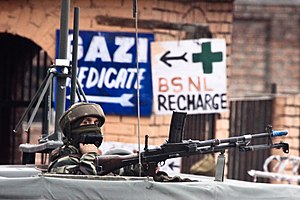
India has a mixed record on human rights: since independence, there have been periods when they have been under grave threat. This includes the Emergency of 1975-77 when human rights and the rule of law were suspended, and India ruled by decree; at the same time, a mass sterilization campaign saw many men sterilized against their will.[25][26] Narendra Modi's government seems to threaten a similar era of rights abuse.[27] India's minorities, including non-Hindu religious groups such as Muslims and Sikhs and lower-caste Hindus, have seen changes in their status. Different governments have alternately tried to provide help and victimized or scapegoated them.
Since Modi's arrival in 2014, India's score on Freedom House's Freedom in the World Index fell from 77/100 (Free)[28] to 67 (Partly Free) in 2022.[29] Indian Kashmir's score went down drastically, from 49 (Partly Free) in 2014[28] to 27 (Not Free) in 2021.[30] India's ranking on the EIU Democracy Index has also fallen, from 27 in 2014 to 53 in 2020,[31] now being dubbed a "flawed democracy". India's V-Dem Democracy ratings also tell a similar tale, classifying India as an "electoral autocracy" leading the "third wave of autocratisation".[32]
Internet shutdowns[edit]
India has the highest number of internet shutdowns anywhere in the world.[33][34] In 2020, more than 70% of global internet shutdowns happened in India alone.[35] Most of these shutdowns were found to not be following the law.[36]
These internet shutdowns have been shunned by experts as 'economic self-harm', leading the Indian economy to suffer billions of dollars.[37]
Most of these shutdowns happened in Kashmir after the abrogation of Article 370.
Sikhs[edit]
Sikhs are concentrated mainly in the province of Punjab. An insurgency in the early 1980s saw the Golden Temple in Amritsar being occupied by Militants and a three-day battle to remove them, leaving hundreds dead, including a high number of civilian casualties. The attack on the temple was seen by Sikhs worldwide as an attack on the Sikh religion fueling the insurgency, leading to the assassination of Indira Gandhi and the 1984 Anti-Sikh Riots seeing the deaths of between 8,000 and 17,000 Sikhs. Extremist violence and terrorism targeting Sikhs and Hindus would continue for 10 years, eventually petering out with diminishing public support and operations by security services.
Muslims[edit]
India also has a mixed record in how it treats its Muslim minority. This includes the 2002 Gujarat riots,![]() which saw 790 Muslims and 254 Hindus killed, widespread rape and looting, and destruction of homes; Narendra Modi was Chief Minister of Gujarat at the time and is accused of allowing the murder of hundreds of Muslims.[38] In 2018 the US State Department condemned India's treatment of Muslims in its annual report on religious freedom, condemning mob violence and possible collusion by the police.[39]
which saw 790 Muslims and 254 Hindus killed, widespread rape and looting, and destruction of homes; Narendra Modi was Chief Minister of Gujarat at the time and is accused of allowing the murder of hundreds of Muslims.[38] In 2018 the US State Department condemned India's treatment of Muslims in its annual report on religious freedom, condemning mob violence and possible collusion by the police.[39]
Christians[edit]
Being one of the few actual persecution cases of that kind, there has been a drastic increase in violence against the Christian minority since the late '90s. Notably, in 2008, Hindutva organizations incited violence in the Kandhamal district of Orissa with the deaths of 36 Christians and the destruction of 365 churches and 3906 households.[40]
Casteism[edit]

Though discrimination based on caste is illegal, there is a long history of violence between castes, involving higher castes and low-caste people.[41]
India comprises 9% Scheduled Tribes, 20% Dalits, 41% Other Backward Classes, and only 30% of the Forward Caste.[42] Despite this...
- Intercaste marriages in India only make up around 5.8% of all marriages in India, although when the groom's mother was more educated, this was found to go up.[43]
- A survey from 2018 asked non-Dalits whether there "should be a law preventing high caste and low caste people from marrying each other?" Support for such a law ranged from 60% in rural Rajasthan and 40% in India's capital, Delhi.[44]
- They are underrepresented in the Indian legislature.[45]
- Similarly, qualified SC candidates are less likely to be hired than the general category ones.[citation needed]
The biggest caste survey in 2014 showed that 1 in 4 Indians practiced untouchability, with more than 52% of Brahmins and 24% of non-Brahmin upper castes who practiced untouchability. The upper castes have also brought their casteism abroad. Even for 'educated' ones with post-grad education, 48% and 27% still practiced untouchability.[46] Untouchability is not a savage practice long gone since the 1900s; this is 67 years after India's independence.
In many schools, in the absence of sweepers, Dalit girls are made to clean the school toilets.[47][48] Government schools still divide students into rows based on their caste.[49]
Kashmir[edit]
In 2019 Modi suspended the autonomy![]() of Kashmir and enforced martial law to curb militancy in the region.[50] This led to large protests, which led to a few deaths.
of Kashmir and enforced martial law to curb militancy in the region.[50] This led to large protests, which led to a few deaths.
Homosexuality[edit]

Historically, since ancient times, gay rights have been recognized in India.[51] Upon British rule, homosexuality was made illegal and was classified as "carnal intercourse against the order of nature", punishable by imprisonment from 10 years to life. Some journalists have argued that the Victorian-era values imposed by the British colonialists have influenced this homophobia and the anti-gay laws.[52][53] Leaders of the Indian National Congress,[54] Aam Aadmi Party,[55] the Communist Party of India (Marxist),[56] and even the right-wing Bharatiya Janata Party[57] have voiced support for the legalization of homosexuality. In 1996 a film named Fire caused a lot of controversy in India due to its positive portrayal of lesbianism. In 2009, a court order was passed removing the bans on gay sex imposed by the British.[58][59] However, on 11 December 2013, the Indian Supreme Court overturned the 2009 court order and re-criminalized gay sex, saying it was an issue to be dealt with in Parliament.[60] However, in 2017, new judges in the Indian Supreme Court determined there was a right to privacy in the constitution, and in 2018 they said gay sex is not wrong and have reversed the verdict on the section, saying it would be decided in a few months.[citation needed]
However, marriage equality and same-sex unions are still not recognized by the Indian government.
On 6 September 2018, the bans on homosexuality were ruled unconstitutional.[61]
Women[edit]

It is not unusual for women to hold high office and positions of influence and the height of the glass ceiling is roughly comparable to that in Western countries. However, the patriarchy remains dominant, and gender-specific crimes against women are shockingly prevalent.
Female foeticide is also prevalent, with most Indians preferring sons over daughters, seeing them as 'liabilities' and sons as 'investments'.[62] One report ranks India the "fourth most dangerous country for women."[63]
Acid attacks[edit]
"If you love something, set it free. If it comes back, it's yours. If it doesn't, it never was mutilate it beyond recognition" appears to be the philosophy of many lovestruck Indian men. Acid attacks are almost solely revenge attacks against women who spurn the advances or proposals of the attacker (or who seek a divorce). The extent of permanent disfigurement is equivalent to 3rd-degree burns and often results in blindness and a life behind closed doors. Like most other crimes listed here, acid attacks rose in 2008[64] but dropped since 2016.[65][66]
Sexual harassment and rape[edit]
Eve Teasing is a blanket term commonly used to describe all manner of sexual harassment ranging from catcalls to violent sexual assault. Even the media uses the term, and, needless to say, it trivializes the gravity of crimes being reported.
Much sexual harassment happens in the workplace. Much happens in public. We aren't just talking about wolf whistles. We are talking about fatal gang rape.[67]
Dowry[edit]
- See the Wikipedia article on Dowry system in India.
Despite being outlawed for 50 years,[68] the practice is still widespread. If payment from the bride's family is not forthcoming, the groom's family (or the groom himself) may seek violent redress, often resulting in death. "Kitchen fires" happen with alarming frequency in households where a dowry dispute occurs.
Thousands of women die in India each year due to dowry abuse.
Domestic violence[edit]
Around 50% of women justify men beating their wives.[69]
So you've decided to reincarnate as a woman in India anyway[edit]
Of course, the trials and tribulations of being a woman in India can be easily avoided if you get aborted first. We are not referring to pro-choice abortion here; the mother rarely has a say in the matter. Systemic termination of female fetuses and newborns has a long history in India, and it continues today, despite the government declaring it illegal.[70][71] There are two principal reasons for this. Males are traditionally the breadwinners, and prospective parents have a better chance of being financially provided for in their dotage. The second reason is dowry. Receiving a dowry is more attractive than paying one.
If you survive birth or infanticide, you stand a 27% chance of being married off while still a minor.[72] The practice has been outlawed since 1929,[73] but hey, Rome wasn't built in a day. Notably, the 1929 law fixed girls' marriage age at 14, but it was amended in 1940 to 18. The age of consent is 18 for unmarried girls but 16 for married girls making forced marriage easier.[74]
Becoming a child bride isn't the worst that could happen. Child trafficking for forced labor, prostitution, or domestic servitude (a.k.a. rape) is a thriving industry that victimizes India's poor and marginalized communities.[75]
Woo and pseudoscience in India[edit]
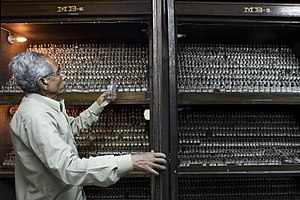
India has significantly contributed to STEM in fields such as medicine, engineering[note 7], metallurgy, mathematics, etc. Article 51A(h) of the constitution of India states that it is a fundamental duty of an Indian to to develop the scientific temper, humanism and the spirit of inquiry and reform. Hopefully, nobody thinks that the world's largest constitution is plagiarized from foreign countries.
Established religious beliefs aside, much woo is accepted and practiced in India. In poor, rural regions, you may still find people subject to attacks based on accusations of witchcraft. Medical pseudoscience is widely accepted. Standing up to scientific scrutiny simply doesn't enter the picture. A relatively more recent "medical practice", Homeopathy, has gained widespread popularity. India has at least one large hospital devoted to the practice of Unani, a type of heroic medicine. The health and well-being of millions of Indians are compromised daily because of the pervasiveness of many such superstitions.
A peculiar aspect of Indian politics is that many politicians pay homage to religious leaders in their ashrams, not just to traditional Hindu or Muslim leaders but even to transparent charlatans like the late charismatic Sathya Sai Baba. The organizations of the latter were involved in a lot of charity.
Some Indian gurus formed with their ashrams a state within a state, but there seems to be some change to it lately after fraudulent "gurus" such as Asaram Bapu![]() and Gurmeet Ram Rahim Singh
and Gurmeet Ram Rahim Singh![]() were arrested for sexual assault. Gurmeet Ram Rahim Singh has been convicted in a murder case and two rape cases as of 2019.[76]
were arrested for sexual assault. Gurmeet Ram Rahim Singh has been convicted in a murder case and two rape cases as of 2019.[76]
Rice pullers and other bizarre scams abound to fleece the unwary.
Religious tradition has made it taboo to eat the world's tastiest animal that isn't bacon. A workaround for this is eating buffalo, which isn't the same thing.
Astrology[edit]
Status of astrology in India[edit]
India's belief in Astrology is unique because of its expansiveness and scientific status. The usage of the phrases like real astrology or scientific astrology is widespread. These phrases distinguish scripturally learned astrologers from the 'unscientific' ones. Basically, it is to distinguish between someone who would blatantly look stupid from those who behave like they know what they are doing. Indian space research, considered at the forefront of scientific advancement, is making quick and appreciable progress. However, even scientists at the formidable Indian Space Research Organisation (ISRO) have indulged in ritualistic astrological practices.[77] This could seem contradictory to a scientist somewhere other than India, but this is the nature of the Indian mindset.[78]
Astrology in life[edit]
Astrology plays a vital role in match-making throughout India. Prospective grooms' and brides' horoscopes are matched before they get married. There are doshams (faults) in horoscopes that need remediation also. These doshams are also said to lead to spouse deaths. Incredibly primitive rituals are also followed for remediation many times, like getting ritually married to trees or animals before the actual marriage. These are not rare occurrences. Astrologers promise everything to their clients, e.g., better pay, better business, good-looking spouse, resolution of disputes, disposal of enemies, etc. Marriage, birth, death, and other emotionally challenging life events make astrologer a major market.
Astrologer remedies[edit]
The most common remedy is doing a Pooja (ritual prayer), which is done by a designated priest. Another prevalent remedy is wearing stones to placate/strengthen a strong/weak celestial body in your horoscope. All the celestial bodies, e.g., Mars, Jupiter, Moon, etc., have their own respective stones. This is a vast market in India. It is widespread to see Indian people wearing rings with stones on their fingers. Remedies go from benign to harmful and play on the believers' psychological weakness.
Expanse of belief[edit]
It is a myth that only Hindus in India believe in Astrology. It is a commonly and diversely held belief. Typically, Muslims, Christians, and other religions in India commonly believe in Astrology. Diversely because no one text or belief system is followed. Belief systems are very different.[citation needed]
India's modern achievements[edit]
Climate change[edit]
- Five years after the Paris climate accord, India is the only G20 nation to meet the emission target of 2020.[79]
- India is the only developing country to get into the Top 10 in CCPI (Climate Change Performance Index) 2019.[80]
Birth rate[edit]
- The birth rate in India is falling rapidly, currently at 2.3.[81] While India is still relatively young and thus will continue to grow quite a bit, it's quickly leveling off.
Astronomy[edit]
Despite being a developing country, India is one of the major superpowers in the space industry. India’s own government space agency is ISRO. Some of its achievements are...
- The MOM (Mars Orbiter Mission) or Mangalyaan (Mars-Craft in Sanskrit) made India the 4th nation to go to Mars.[82] It cost the Indian government only 74 million dollars, which is lower than the budget of most Hollywood movies, and just 11% of NASA’s Mars Orbiter Missions, making it the cheapest Mars mission in the world.[83][84]
- On 18 June 2016, ISRO launched twenty satellites in a single vehicle, and on 15 February 2017, ISRO launched one hundred and four satellites in a single rocket (PSLV-C37), another unbeaten world record.[85][86]
Science[edit]
- India lies third in the quantity of peer-reviewed publications.
- It has the third-largest pharmaceutical exports.
Dissent[edit]
- Indian farmers and workers pulled off the world's largest one-day strike
 on 26 November 2020 to protest against changes to labor laws and attempts to suppress farmers' rights.
on 26 November 2020 to protest against changes to labor laws and attempts to suppress farmers' rights.
- On 19 November 2021, Narendra Modi repealed the controversial farm laws after a year of protests.[87]
- After killing millions of citizens through overconfidence and negligence and covering it up by underreporting cases, silencing dissent, and playing the blame game, the following of Modi’s personality cult is at an all-time low due to the mishandling of the coronavirus crisis in India.[88]
Gallery[edit]
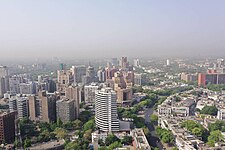
Skyline of Cannaught Place, the financial centre of New Delhi.
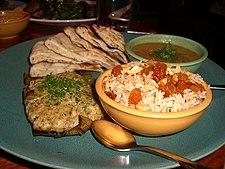
An Indian meal.
_in_Amritsar,_India.jpg)
Sikh man at the Golden Temple in Amritsar.
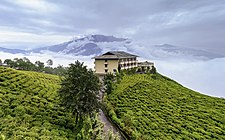
Tea plantation in Sikkim.
.jpg)
Female health workers working to vaccinate people.
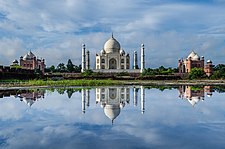
Taj Mahal
See also[edit]
- Iran
- Pakistan
- Bangladesh
- Kashmir
- Hinduism
- Zoroastrianism
- Bal Thackeray
- Michael Cremo
- Nirmukta
- B. R. Ambedkar
- Lemuria
Notes[edit]
- ↑ Of course, the Americans among us can't exactly criticize them for that.
- ↑ Canada has two provinces, Saskatchewan and Quebec, who are currently run by their own regional parties, both conservative: the Saskatchewan Party and the Coalition Avenir Quebec.
- ↑ Hiya!.
- ↑ Insurgent groups operating in India against the Indian government
- ↑ Prevention of Terrorism Act, a controversial act which was criticized by human rights activists for human rights violations
- ↑ A disputed territory which is the source of military conflicts between India and Pakistan
- ↑ It's not like they could have chosen Arts or Commerce
References[edit]
- ↑ https://www.worldometers.info/world-population/india-population/
- ↑ http://articles.timesofindia.indiatimes.com/2011-01-28/india/28368698_1_savarkar-national-flag-digvijay-singh
- ↑ How the Congress tarnished its secular image — and its credibility to oppose Hindutva, Quartz India
- ↑ Perks Of Being An Atheist While Politicians Promote Communal Divide by Pramit Chaterjee
- ↑ See the Wikipedia article on Shiv Sena § Activities and criticism.
- ↑ See the Wikipedia article on Bajrang Dal § Controversies.
- ↑ See the Wikipedia article on Vishva Hindu Parishad § Other activities.
- ↑ The Wall Street Journal: India Defies Turmoil With Growth of 8.8% May 31, 2008
- ↑ India inching closer to China, will be an eco powerhouse by 2030: US report December 11, 2012
- ↑ World Bank Report 2018, Chapter 1, page 26
- ↑ Wiener, Jon. "How We Forgot the Cold War. A Historical Journey across America"
- ↑ Triennial Central Bank Survey, Foreign exchange turnover in April 2013: preliminary global results (PDF)
- ↑ https://economictimes.indiatimes.com/news/politics-and-nation/india-ranks-fourth-in-global-slavery-survey/articleshow/52528778.cms
- ↑ https://www.globalhungerindex.org/ranking.html
- ↑ https://www.newslaundry.com/2021/12/02/hunger-games-decoding-the-global-hunger-index-and-the-government-response-it-elicited
- ↑ GlobalSecurity.org: Indian Navy
- ↑ GlobalSecurity.org: Indian Air Force
- ↑ Bharat Rakshak
- ↑ rediff.com: Are you cut out for a career in the Armed Forces? April 17, 2008
- ↑ Arab News: Two Saudi warships to visit India July 27, 2008
- ↑ MISSLETHREAT.com: The Threat from India
- ↑ uthr.org
- ↑ "Naga movement: A brief history and peace accord with the Indian government", Zee News, 4 Aug 2015
- ↑ http://www.rediff.com/news/slide-show/slide-show-1-india-fourth-most-terror-affected-country-in-the-world/20121207.htm
- ↑ See the Wikipedia article on The Emergency (India).
- ↑ In 1976, more than 6 million men in India were coerced into sterilization, Mel Magazine
- ↑ A new India is emerging, and it is a country ruled by fear, Amit Chaudhuri, The Guardian, 8 Oct 2019
- ↑ 28.0 28.1 https://freedomhouse.org/sites/default/files/FIW2014 Booklet.pdf
- ↑ https://freedomhouse.org/country/india/freedom-world/2022
- ↑ https://freedomhouse.org/country/indian-kashmir/freedom-world/2021
- ↑ https://economictimes.indiatimes.com/news/politics-and-nation/india-falls-to-53rd-position-in-eius-democracy-index-dubbed-as-flawed-democracy/articleshow/80665859.cms
- ↑ https://thewire.in/rights/india-no-longer-democracy-electoral-autocracy-v-dem-institute-report-bjp-narendra-modi
- ↑ https://internetshutdowns.in/
- ↑ https://www.accessnow.org/keepiton-report-india-shuts-down-internet-more-than-any-other-nation-on-earth//
- ↑ https://timesofindia.indiatimes.com/india/70-of-global-internet-shutdowns-in-2020-were-in-india-report/articleshow/81321980.cms
- ↑ https://www.newslaundry.com/2021/10/29/in-india-are-internet-shutdowns-in-accordance-with-law-not-always
- ↑ https://www.business-standard.com/podcast/current-affairs/internet-shutdowns-bleeding-businesses-hitting-country-s-image-121120900067_1.html
- ↑ Narendra Modi 'allowed' Gujarat 2002 anti-Muslim riots, BBC News, 22 Apr 2011
- ↑ India's treatment of Muslims condemned by US government report, Independent, 23 Jun 2019
- ↑ In photos: Damaged churches, broken homes are the lingering scars of the 2008 Kandhamal riots
- ↑ See the Wikipedia article on Caste-related violence in India.
- ↑ https://www.statista.com/statistics/1001016/india-population-share-by-caste/
- ↑ https://theprint.in/opinion/inter-caste-marriage-india-groom-mother-educated-study/526481/
- ↑ https://www.researchgate.net/publication/322492420_Explicit_prejudice_Evidence_from_a_new_survey
- ↑ https://www.outlookindia.com/magazine/story/india-news-70-years-of-indian-judiciary-opinion-composition-terribly-skewed-higher-levels-bastion-of-upper-caste-males/302658
- ↑ https://indianexpress.com/article/india/india-others/one-in-four-indians-admit-to-practising-untouchability-biggest-caste-survey/
- ↑ https://www.indiatoday.in/india/story/dalit-girls-clean-school-toilets-sweepers-jaipur-swachch-bharat-abhiyan-240934-2015-02-19
- ↑ http://archive.indianexpress.com/news/in-rural-gujarat-schools-cleaning-toilets-is-still-the-job-of-dalit-students/373553/
- ↑ https://timesofindia.indiatimes.com/india/Government-school-students-divide-mid-day-meals-on-caste-basis/articleshow/43032900.cms
- ↑ https://time.com/5832256/kashmir-lockdown-coronavirus/
- ↑ https://www.galva108.org/single-post/2014/05/15/Homosexuality-Hinduism-the-Third-Gender-A-Summary
- ↑ The Guardian: India's literary elite call for anti-gay law to be scrapped September 17, 2006
- ↑ Lesbilicious: India debates legality of homosexuality October 15, 2008
- ↑ Bloomberg: Gandhi Slams India Court on Gay Rights in Shift for Ruling Party December 12, 2013
- ↑ India TV: No ban on gay sex, says AAP December 13, 2013
- ↑ People's Democracy: AIDWA Welcomes SC Directive February 10, 2002
- ↑ SC must review Sec 377 ruling, allow gay relationships: Jaitley, Chidambaram November 29, 2015
- ↑ newser: India Legalizes Gay Sex July 2, 2009
- ↑ See the Wikipedia article on Fire (1996 film).
- ↑ The Hindu: Supreme Court sets aside Delhi HC verdict decriminalising gay sex December 12, 2013
- ↑ India court legalises gay sex in landmark ruling, BBC News
- ↑ https://www.dw.com/en/why-many-indians-prefer-sons-over-daughters/a-42385733
- ↑ The World's Five Most Dangerous Countries for Women. Archived from the original at trust.org.
- ↑ India's acid victims demand justice. BBC, 9 April 2008.
- ↑ Crime in India - 2016. National Crimes Records Bureau, Ministry of Home Affairs (India).
- ↑ Crime in India - 2017. National Crimes Records Bureau, Ministry of Home Affairs (India).
- ↑ Six Charged With Murder in India After Rape Victim’s Death by Heather Timmons, Niharika Mandhana and Sruthi Gottipati, New York Times
- ↑ Dowry Prohibition Act
- ↑ https://www.onmanorama.com/news/kerala/2021/11/28/kerala-women-52-percent-justify-man-beating-wife-national-family-health-survey.html
- ↑ http://www.thehindu.com/news/national/india-loses-3-million-girls-in-infanticide/article3981575.ece
- ↑ https://www.downtoearth.org.in/news/health/india-witnesses-one-of-the-highest-female-infanticide-incidents-in-the-world-54803
- ↑ Table 11, Child Protection, UNICEF
- ↑ See the Wikipedia article on Child Marriage Restraint Act.
- ↑ Govt Stands By 1949 Law Allowing Men Sex With 15-Yr-Old Wives
- ↑ Child Trafficking and You.
- ↑ https://www.ndtv.com/india-news/jailed-godman-gurmeet-ram-rahim-convicted-in-murder-of-journalist-1976311
- ↑ https://www.outlookindia.com/website/story/india-news-opinion-was-isro-chief-right-in-offering-prayers-ahead-of-chandrayaan-2-launch/334944
- ↑ https://www.npr.org/sections/parallels/2014/09/25/351373672/in-india-scientific-prowess-and-fascination-with-astrology-co-exist
- ↑ 5 years after Paris climate accord, India only G20 nation to meet emission target - Where do other countries stand? by FPJ Web Desk (Thursday, November 19, 2020, 11:19 AM IST) Free Press Journal
- ↑ CCPI
- ↑ India fertility rate halves over 40 years
- ↑ Chang, Jon M. (5 November 2013). "India Launches Mars Orbiter Mission, Heralds New Space Race". ABC News. Retrieved 6 November 2013.
- ↑ "India Successfully Launches First Mission to Mars; PM Congratulates ISRO Team". International Business Times. 5 November 2013. Retrieved 13 October 2014.
- ↑ Bhatt, Abhinav (5 November 2013). "India's 450-crore mission to Mars to begin today: 10 facts". NDTV. Retrieved 13 October 2014.
- ↑ "ISRO sends record 104 satellites in one go, becomes the first to do so". The Economic Times. Archived from the original on 15 February 2017. Retrieved 15 February 2017.
- ↑ Barry, Ellen (15 February 2017). "India Launches 104 Satellites From a Single Rocket, Ramping Up a Space Race". The New York Times. ISSN 0362-4331. Archived from the original on 5 April 2017. Retrieved 15 February 2017.
- ↑ https://www.ndtv.com/india-news/pm-narendra-modi-says-3-farm-laws-to-be-withdrawn-2616711
- ↑ https://www.reuters.com/world/india/pm-modis-rating-falls-india-reels-covid-19-second-wave-2021-05-18/
Categories: [Anti-Christian bigotry] [Authoritarian regimes] [Fundamentalism] [Hinduism] [Islamophobia] [Islam] [India] [South Asian countries] [Asian countries] [Territorial disputes]
↧ Download as ZWI file | Last modified: 03/10/2025 07:28:53 | 171 views
☰ Source: https://rationalwiki.org/wiki/India | License: CC BY-SA 3.0
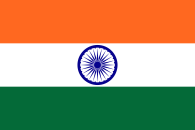
 KSF
KSF